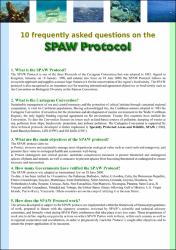| Author | United Nations Environment Programme (UNEP) | |
| Author | Caribbean Environment Programme (CEP) | |
| Accessioned date | 2023-12-12T13:43:49Z | |
| Available date | 2023-12-12T13:43:49Z | |
| Year | 2023 | |
| Citation | United Nations Environment Programme (UNEP), Caribbean Environment Programme (CEP) (2023). 10 frequently asked questions on the SPAW Protocol. Kingston, Jamaica: UNEP Caribbean Environmental Programme. Recuperado de: | es |
| URI | https://bvearmb.do/handle/123456789/3739 | |
| Abstract | Contents: 1. What is the SPAW Protocol? -- 2. What is the Cartagena Convention? -- 3. What are the main objectives of the SPAW protocol? -- 4. How many Governments have ratified the SPAW Protocol? -- 5. How does the SPAW Protocol work? -- 6. What are some of the main obligations following ratification? -- 7. How can countries get assistance to implement the obligations of the SPAW Protocol? -- 8. What are the main benefits for countries from ratification? -- 9. How does a country ratify/accede to the SPAW Protocol? -- 10. Which partners are involved in the SPAW Protocol? | es |
| Language | English | es |
| Published | Kingston, Jamaica: UNEP Caribbean Environmental Programme | es |
| Rights | © United Nations Environment Programme (UNEP); Caribbean Environment Programme (CEP), 2023. | es |
| Subject | Gestión ambiental - Políticas y normas | es |
| Subject | Gestión ambiental - Legislación y Derecho | es |
| Subject | Acuerdos internacionales | es |
| Subject | Biodiversidad | es |
| Subject | Conservación ambiental | es |
| Title | 10 frequently asked questions on the SPAW Protocol | es |
| Material type | Booklet | es |
| Type of content | News - Informative | es |
| Access | Open | es |
| Audience | Technicians, professionals and scientists | es |


